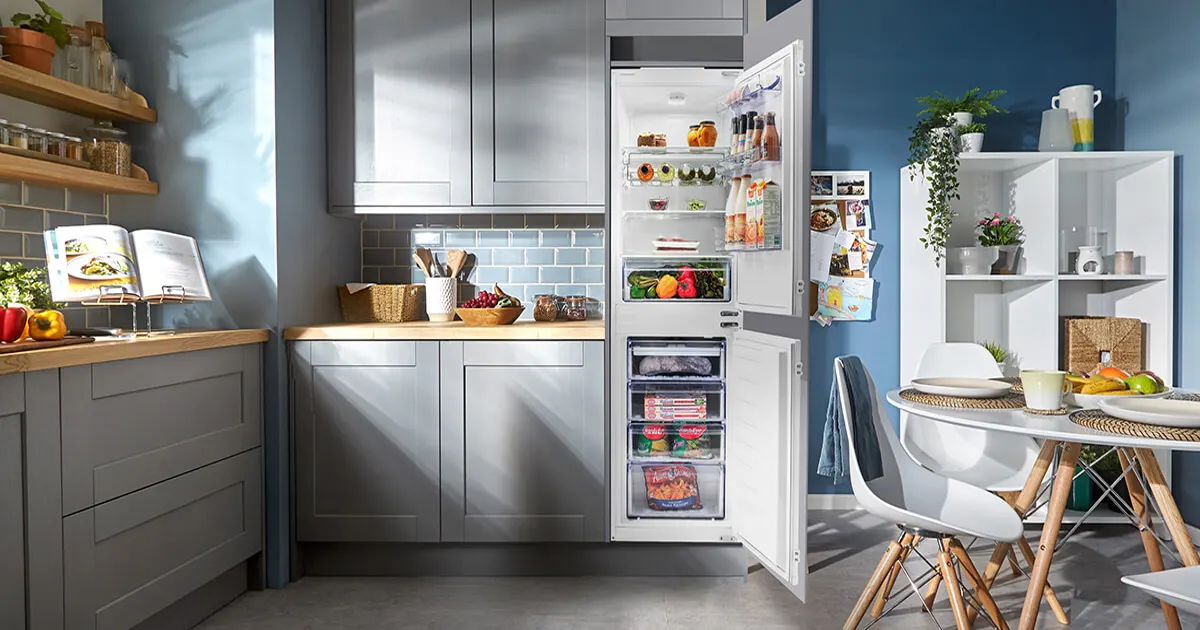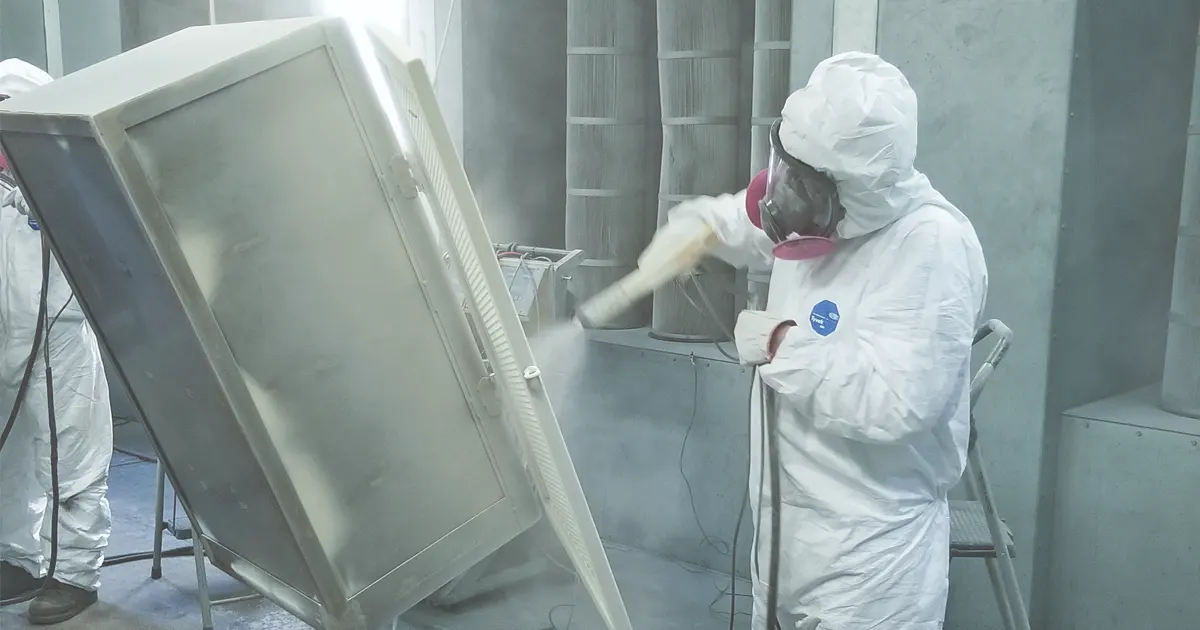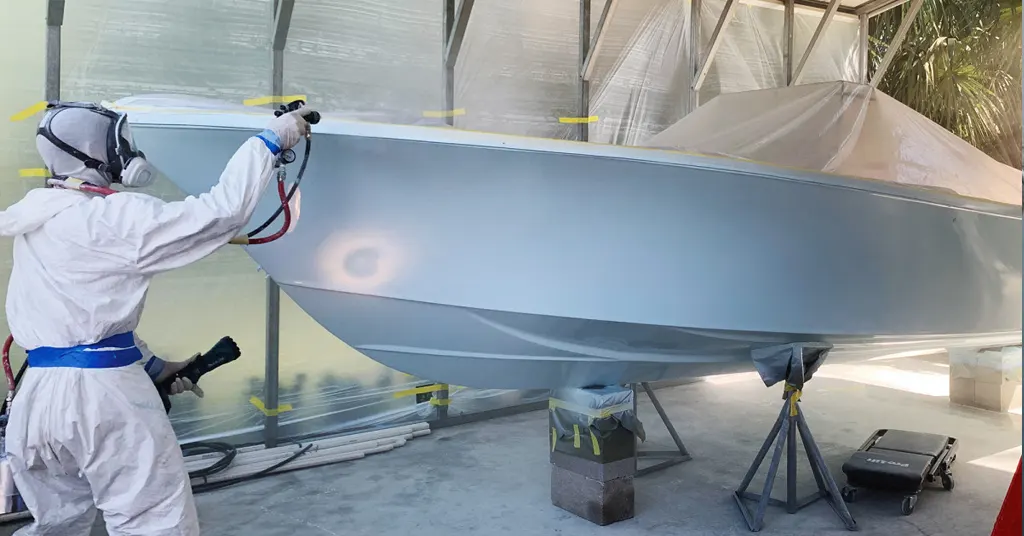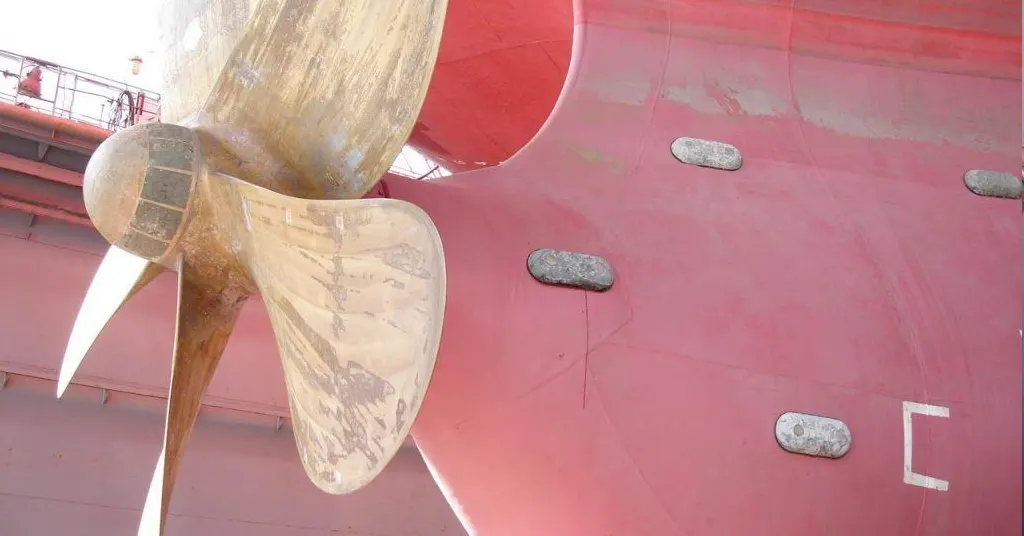Epoxy Polyester Powder Coating
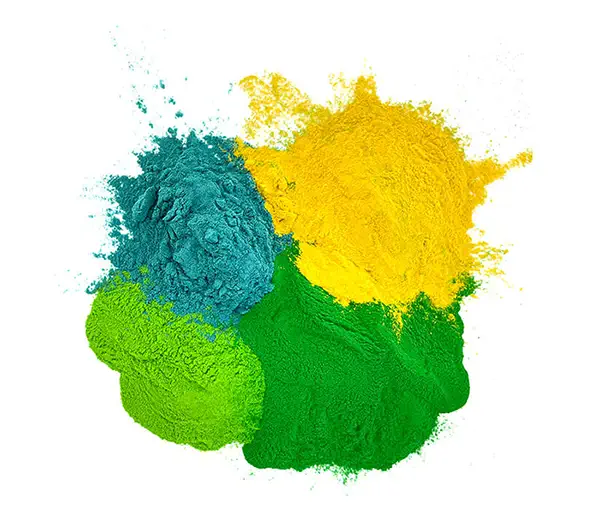
Indoor Hybrid Epoxy Polyester Powder Coating
- Type : Hybrid Epoxy Polyester Powder Coating
- Sample: Free Sample Supported
- Ratio : 80/20 ; 70/30 ; 60/40; 50/50 Etc.
- Color : Customized Supported
- Gloss : Customized Supported
- Texture : Customized Supported
- Package : 20KG Or 25KG/Carton Or Customized Supported
- Delivery : 2-5 Days
Product Performance
- Excellent Leveling And Gloss
- Great Mechanical &Chemical Performance , Excellent Anti Corrosion;
- Better Anti Heat Property And Stable Performance Than Pure Epoxy Resin Powder Coating
Application: Household Appilance , Industry Equipment,Shelf,Furniture,Car Spare Parts,Hardware,Toys,Lights Etc.
| Density | 1.2-1.8 G/cm³ |
| Film | Film Thickness :40u~150um , Best Recommendation Is 40um~80um |
| Utilization Rate | Average Coverage : 8~12 Square Meter/Kg ,With 60um (100% Use Rate) |
| Curing Condition | 160°C/10min;180°C/10min ;180°C/15min;190°C/15min ;200°C/10min; Or Customized According To Requirements |
| Method | Corona Electrostatic Spraying ,Electrostatic-Fluidized Bed, Fluidized Beds,Tribo Charging Guns |
| Applicaiton | Mainly For Interior Use, Such As Auto Parts , Electrical Appliances, Metal Furniture, Computers, Refrigerators, Etc. |
| Transportation | Two Layers Of Polyvinyl Chloride Plastic Bags In Carton Package, 20 /25kg Per Carton. Non-Dangerous Goods Can Be Transported In Various Ways, But Avoild From Direct Sunlight, Moisture And Heat, And Contact With Chemical Substances. |
| Safety | Non Toxic Substances, And There Is No Toxic Gas Generated During Baking, But Avoid Inhaling Dust During Use, Operators Should Wear Dust Masks, And Minimize The Long-Term Contact Between Skin And Powder Coatings, Which Adhere To The Skin The Paint On The Surface Can Be Cleaned With Soap. |
What is Epoxy Polyester Powder Coating and how does it work?
Epoxy polyester powder coating is a type of thermosetting powder coating used to protect and enhance the appearance of metal and other materials. It is a popular choice for coating items such as appliances, automotive parts, outdoor furniture, and various industrial components. This coating is created by combining epoxy resins and polyester resins with various additives and pigments.
Here’s how epoxy polyester powder coating works:
Preparation: Before applying the powder coating, the metal or substrate to be coated is cleaned and prepared. This typically involves removing any contaminants, such as oils, rust, or old paint, and then applying a pre-treatment, such as a phosphate or chromate conversion coating, to improve adhesion and corrosion resistance.
Powder Application: The epoxy polyester powder coating is applied to the prepared surface using an electrostatic spray gun or a fluidized bed. In the electrostatic method, the powder particles are given an electrostatic charge, which causes them to be attracted to the grounded substrate. This ensures a uniform and even coating.
Curing: After the powder is applied, the coated item is moved to a curing oven. The curing process is essential for thermosetting powder coatings like epoxy polyester. It involves exposing the coated item to high temperatures, typically between 350°F to 400°F (175°C to 200°C), for a specific period, usually around 10-30 minutes. During this time, the powder particles melt and chemically crosslink, forming a durable, continuous film.
Cooling: After curing, the coated item is allowed to cool gradually to room temperature. This cooling process is essential to ensure that the coating achieves its desired hardness and properties.
What are the differences between pure polyester and epoxy powder coatings?
| Durability: Epoxy polyester powder coatings are highly durable and resistant to various environmental factors, including corrosion, chemicals, moisture, and UV radiation. This durability makes them suitable for both indoor and outdoor applications, where the coating must withstand harsh conditions. | Versatility: These coatings can be formulated in a wide range of colors, finishes, and textures, allowing for customization to meet specific aesthetic requirements. Whether a smooth, glossy finish or a textured, matte surface is desired, epoxy polyester powder coatings can deliver. |
| Adhesion: Epoxy polyester powder coatings adhere well to various substrates, including metals like steel and aluminum, as well as some plastics and composites. This strong adhesion contributes to the coating's longevity and effectiveness. | Environmental Benefits: Powder coatings, including epoxy polyester, are considered more environmentally friendly than liquid coatings because they contain no solvents or VOCs (volatile organic compounds). This reduces air pollution and makes them compliant with stricter environmental regulations. |
| Efficiency: Powder coating processes are efficient and produce minimal waste. Overspray powder can be collected and reused, reducing material waste and lowering overall production costs. | Consistency: Powder coating provides a consistent and uniform thickness of the coating layer, eliminating issues related to runs, sags, or drips often associated with liquid coatings. |
| Quick Curing: The curing process for epoxy polyester powder coatings is relatively fast. This allows for efficient production processes and quicker turnaround times compared to some other coating methods. | Scratch and Impact Resistance: Epoxy polyester coatings offer good scratch and impact resistance, making them suitable for applications where the coated item may experience wear and tear. |
| Wide Range of Applications: These coatings are used in diverse industries, including automotive, appliances, architectural, furniture, and industrial equipment, demonstrating their versatility and effectiveness in various applications. | Longevity: Epoxy polyester powder coatings have a long service life, reducing the need for frequent recoating or maintenance, which can lead to cost savings over time. |
What is the difference between Epoxy Powder Coating and Polyester Powder Coating?
| Epoxy Powder Coating | Polyester Powder Coating | |
| Resin Composition | Epoxy powder coatings are primarily composed of epoxy resins. Epoxy resins provide excellent adhesion, chemical resistance, and corrosion protection. They are known for their toughness and durability. | Polyester powder coatings are formulated with polyester resins. Polyester resins are known for their flexibility and exterior durability. They offer good UV resistance and color retention. |
| Chemical Resistance | Epoxy coatings excel in chemical resistance and are often used in applications where exposure to chemicals, solvents, or corrosive substances is a concern. | Polyester coatings are generally less chemically resistant than epoxy coatings but still provide good resistance to many environmental factors. |
| UV Resistance | Epoxy coatings tend to be less UV-resistant than polyester coatings. They may not be suitable for prolonged exposure to direct sunlight, as they can degrade and lose color over time. | Polyester coatings are known for their excellent UV resistance, making them a preferred choice for outdoor applications where color stability is essential. |
| Flexibility | Epoxy coatings are relatively rigid and less flexible compared to polyester coatings. They may be prone to cracking or chipping if subjected to significant flexing or bending. | Polyester coatings are more flexible and can better withstand bending and flexing without cracking. |
| Color and Appearance | Epoxy coatings are available in a limited range of colors and finishes, often with a glossy or semi-gloss appearance. | Polyester coatings offer a broader spectrum of color options and can be formulated with various finishes, including gloss, matte, and textured. |
| Application Areas | Epoxy coatings are commonly used in applications requiring superior chemical resistance and durability, such as industrial equipment, pipelines, and automotive components. | Polyester coatings are preferred for outdoor applications where UV resistance and color retention are critical, including architectural surfaces, outdoor furniture, and agricultural equipment. |
What are safety precautions when using Epoxy Polyester Powder Coating?
Personal Protective Equipment (PPE)
Wear appropriate PPE, including safety glasses or goggles, a lab coat or protective clothing, gloves, and a dust mask or respirator with the correct filters. The type of PPE required may vary based on the specific product and application method, so refer to the manufacturer's recommendations.
Ventilation
Always work in a well-ventilated area, such as a spray booth or a designated powder coating area with proper exhaust systems. Adequate ventilation helps remove airborne powder particles and fumes, reducing the risk of inhalation and exposure.
Respiratory Protection
If there's a potential for inhaling powder particles or fumes, use an appropriate respirator with the correct filters and cartridges. Make sure the respirator is properly fitted and maintained according to manufacturer guidelines.
Eye and Face Protection
Use safety glasses or goggles to protect your eyes from accidental exposure to powder particles. If there's a risk of splashes, wear a full-face shield.
Skin Protection
Wear gloves and protective clothing to prevent skin contact with the powder coating material. Consider the type of gloves required based on the chemicals in the coating and their compatibility with the material.
Fire Safety
Powder coatings are flammable in their powder form. Avoid open flames, sparks, or hot surfaces in the work area. Ensure that fire extinguishing equipment is readily available and regularly maintained.
Powder Handling
Avoid generating dust when handling powder coatings. Use care when transferring and pouring powder to minimize airborne particles. Use equipment designed for powder handling, such as powder transfer pumps and hoses.
Static Electricity
Static electricity can be a hazard when working with powder coatings. Ground all equipment, including the substrate, the spray gun, and the powder containers, to prevent static buildup. Follow proper grounding procedures outlined in the equipment's manual.
Storage and Handling
Store powder coatings in a dry, well-ventilated area away from direct sunlight and heat sources. Keep containers tightly sealed to prevent moisture absorption. Follow the manufacturer's recommendations for storage and handling.
Cleanliness
Maintain a clean work area to minimize the risk of contamination. Use dust collection systems and ensure that the workspace is free from debris and loose powder.
What are the common applications of epoxy polyester powder coatings?
| Appliances: Epoxy polyester powder coatings are frequently used to coat household appliances such as refrigerators, ovens, washing machines, and dryers. The coatings provide a durable and aesthetically pleasing finish that can withstand the rigors of everyday use. | Automotive Parts: Many automotive components, including wheels, engine parts, brackets, and chassis components, are coated with epoxy polyester powder coatings. These coatings offer corrosion resistance and can withstand the demanding conditions of the automotive environment. |
| Furniture: Epoxy polyester powder coatings are used to coat metal and aluminum furniture frames, providing a wide range of color and finish options. Outdoor furniture, in particular, benefits from the UV resistance and durability of these coatings. | Architectural Applications: These coatings are employed in architectural applications such as aluminum window frames, doors, railings, and fencing. They offer excellent weather resistance, color stability, and durability in outdoor environments. |
| Lighting Fixtures: Lighting fixtures, both indoor and outdoor, often feature epoxy polyester powder coatings. These coatings enhance the appearance of fixtures while providing protection against the elements. | Electrical Enclosures: Epoxy polyester powder coatings are used to coat electrical enclosures, cabinets, and control panels. They provide insulation, corrosion resistance, and protection for electronic components. |
| Industrial Equipment: Machinery, equipment, and industrial components benefit from the corrosion protection and durability of epoxy polyester powder coatings. These coatings are used in various industries, including manufacturing, agriculture, and construction. | Tools and Equipment: Hand and power tools, as well as equipment like toolboxes and storage cabinets, are often coated with epoxy polyester powder coatings to improve their appearance and resistance to wear and corrosion. |
| Store Fixtures: Retail store fixtures, including shelving, display racks, and clothing racks, frequently feature epoxy polyester powder coatings. The coatings offer a clean, attractive finish suitable for retail environments. | Garden Equipment: Lawnmowers, garden tools, and outdoor equipment often have epoxy polyester powder coatings to protect them from exposure to moisture, sunlight, and other outdoor elements. |
| Bicycle Frames: Bicycle frames are commonly coated with epoxy polyester powder coatings due to their ability to withstand the rigors of cycling, including exposure to the elements and potential impacts. | Playground Equipment: Playground equipment, such as swing sets and jungle gyms, often incorporates epoxy polyester powder coatings to ensure safety and durability in outdoor settings. |
| Metal Signage: Metal signs and signposts benefit from epoxy polyester powder coatings for their corrosion resistance and ability to maintain vibrant colors in outdoor signage applications. | Fire Hydrants and Street Furniture: Street furniture, including fire hydrants, bollards, and benches, often features epoxy polyester powder coatings for durability in urban environments. |
Have Anything To Ask Us?
